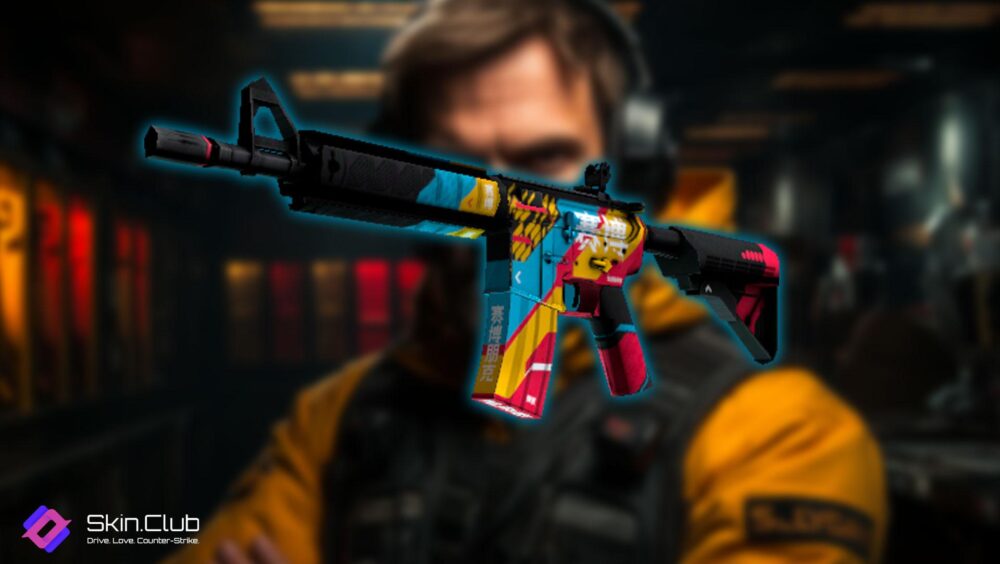In the multicolored, cacophonous world of Counter-Strike: Global Offensive (CS:GO) skins, a unique artifact has captivated the attention of players and collectors alike – the M4A4 | Cyber Security. This skin, with its mesmerizing design and detailed patterns, has made an indelible impact in the vibrant universe of CS:GO. From its inception to its present-day status, its journey offers a unique insight into the evolution and intricacies of this complex domain.
The aim of this article is to analyze this skin’s life course, from its birth to its current role in the dynamic ecosystem of CS:GO. The text will delve into its development, the rarity factors that contribute to its value, its influence on CS:GO culture, its role in eSports, and its overall place in the trading scene.
The Birth
The creation of the skin is a testament to the ongoing community-driven evolution of CS:GO. Developed by a passionate fan, it entered the virtual world after winning a community design contest. The design, paying homage to the intricate world of cyber security, immediately caught the eye of the game’s dedicated fanbase.
Its unique look, distinguished by sleek lines, sharp geometric shapes, and high contrast colors, was inspired by the complexities and enigma of cybernetic security systems. It visually echoes the technicality and precision required in both cyber security and gameplay, a fitting tribute to the game’s own tactical depth and complexity.
The skin’s introduction into the game not only added another dimension to the aesthetics of the gameplay, but it also provided a new collectible for players to strive for. The announcement of its addition sparked widespread excitement, and soon after, it started to build its legacy within the CS:GO community.
Evolution
As with most CS:GO skins, the journey of this skin has been marked by significant evolution. Initially, the skin was highly sought after, but as more players obtained it, its value started to fluctuate in the bustling CS:GO marketplace. However, its inherent beauty and the intrinsic connection to the game’s essence kept it desirable among players and collectors.
With time, it gained recognition not only for its design but also for its impact on gameplay. It became a symbol of prestige, and owning it signified a player’s dedication and commitment to the game. Its status kept soaring, transcending its function as a simple cosmetic item and becoming a coveted token of accomplishment.
Over time, various factors, including its availability, quality grades, and its popularity in eSports, contributed to its market value. Despite the volatility of the virtual marketplace, the skin maintained its allure. Its story mirrors the dynamic nature of the CS:GO skins market, reflecting the myriad of factors that determine a skin’s value and status.
Popularity and Trading Scene
In the trading scene, the skin has carved out a place for itself. Despite the unpredictable nature of skin trading, where values can fluctuate wildly based on trends, demand, and the introduction of new skins, this skin has remained a staple among traders. Its distinct aesthetic and rich history within the game ensure it’s a consistently popular item.
Its popularity has also been fueled by its appearance in many of the game’s random skin crates. This increased availability has made it more accessible to players, encouraging its circulation in the trading scene. Still, even with its heightened availability, the high demand for this skin keeps its trade value relatively stable.
Impact on CS:GO Culture
The skin’s impact extends beyond trading and into the broader CS:GO culture. For many players, this skin is more than just a virtual object; it’s a symbol of accomplishment, an emblem of taste, and an indication of a player’s connection to the game’s community.
From a broader perspective, the skin epitomizes the phenomenon of virtual goods taking on real-world significance. By taking on a life of its own within the CS:GO community, the skin reinforces the notion that virtual items can carry emotional and cultural weight, echoing the evolution of gaming as a social phenomenon.
Rarity and Rarity Factors
The perceived rarity of a skin is a significant factor in determining its value within the CS:GO community. Factors such as the skin’s quality, exterior condition, and drop rate all contribute to its rarity. While this skin may be more readily available than some others, its particular quality grades and conditions contribute to its rarity status.
Skin conditions range from “Battle-Scarred” to “Factory New,” and the condition of this skin significantly impacts its trade value. A “Factory New” version is considered rare and can fetch a higher price in the marketplace. Similarly, its appearance in the game’s skin crates contributes to its perceived rarity. While it has an increased drop rate, the chance of acquiring a “Factory New” variant remains relatively low, maintaining its status as a desirable item.
Rarity is not just about physical characteristics. The skin’s significance within the gaming community, its popularity in eSports, and its recognition among players all contribute to its rarity. The convergence of these factors solidifies its status as a rare and valued artifact within the CS:GO community.
In eSports

The skin’s journey extends into the world of eSports, where it has graced the virtual battlegrounds in many high-stake tournaments. Many professional players have sported it in major competitions, contributing to its prominence and value. It is not uncommon to see this skin flashing across the screen during a tense match, highlighting its cultural significance in the competitive scene.
Moreover, it’s not just about the appearances. The skin has become part of the identity of some players. As eSports athletes often use specific skins, they become intertwined with their online personas, further establishing the skin’s influence in the eSports world.
Conclusion
The journey of the skin through the diverse landscape of CS:GO encapsulates the captivating dynamics of the game’s skin culture. From its creation to its consistent presence in the trading scene, its influence on the game’s culture, and its significance in eSports, the skin stands as a testament to the thriving ecosystem of CS:GO.
As we continue to explore the intersection of gaming, economy, and culture, items like this skin will undoubtedly serve as intriguing case studies. They encapsulate the ever-evolving nature of gaming culture, demonstrating how a virtual artifact can traverse various domains, from design to trade to eSports, creating a unique legacy in the process.
If you enjoy games and gaming and want more NEWS from the Gaming World Click Here








You must be logged in to post a comment.